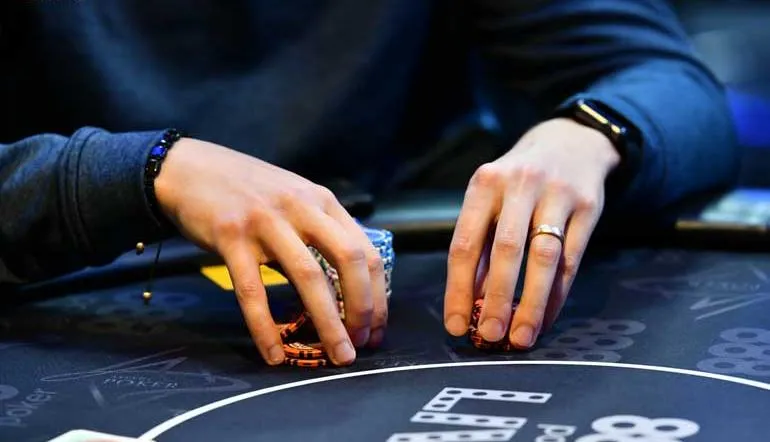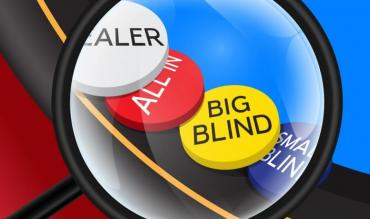Being required to invest one big blind into the pot before seeing a flop is a big disadvantage in a hand of poker.
We should expect to lose in the long run from this position no matter how well we play.
Despite this, BB (big blind) play is extremely important. Good players defend a wide range of hands to limit BB losses and keep overall win rate high.

With that being said, let’s dig into the science behind BB play and cover some top tips for improving our winrate.
The Structure of a BB Defense
Let’s imagine we are in the BB facing an open raise. The correct defense will depend on the following
- The size of the open raise.
- The position of the open raiser.
Having said that, we can still outline a general structure for a defense even before we know these two variables.
Three-betting Range
We can loosely break three-betting hands into two categories.
- Hands that 3bet for value – The strongest hands three-bet preflop simply because they are likely the best hand and prefer to build a pot. Examples include big pairs (e.g., 10-10-plus) and premium broadways (e.g., A-K offsuit, A-J suited-plus).
- Hands that 3bet as a ‘semi bluff’ – We should also three-bet a range of weaker hands that have good postflop playability. Examples include suited broadways, suited connectors/gappers, and offsuit A-x (especially in later positions). Note that most of the hands that three-bet as a semi-bluff also cold call with some frequency. (This is referred to as a mixed strategy.)
- Cold Calling Range – Hands in the cold calling range are not premiums but are too good to fold given the discounted price we get when cold calling out of the BB. In some cases, these hands don’t have the right characteristics for a three-bet. In other cases, these hands will three-bet semi-bluff with some frequency but not all the time (otherwise we would be semi-bluffing too much).
- Folding Range – Some hands are still too weak to be profitably defended from the big blind. It depends on the size of the open and the position of the opener. Theory especially hates disconnected offsuit hands (like J-2 offsuit) and these often end up being folded regardless of the action.
Big Blind Three-bet Terminology
Before jumping into some sample BB defense ranges, let’s tidy up our understanding of the terminology surrounding BB three-bets.
If we three-bet a selection of value hands and semi-bluffs many players might describe this as a polarized range. Although this is commonly accepted terminology it’s arguably misleading.
Consider a couple of reasons why:
- The term polarized implies taking an action with the absolute best and absolute worst hands in our range. When defending out of the big blind, we fold the worst hands in our range. Also, the absolute weakest hands we defend are typically cold calls rather than three-bets.
- The term polarized implies a large gap in the center of our range. Although there are some hands in the center of the range that mostly cold call, these hands are typically mixed into the three-bet range also. Rather than a large gap in the center of the range, we see a smooth transition between value hands and semi bluffs.
- The reason why the term polarization doesn’t describe BB three-betting ranges accurately is because polarization (betting the absolute best and worst hands) is designed to be a river concept. Players have attempted to apply the concept of polarization to preflop play, but it doesn’t fit that well.
- On the other side of the coin, it’s clear that we have both a value component and a semi-bluff component to our range. Also, some of the hands that cold call against an open raise are stronger than some of the hands that three-bet as a semi-bluff.
We can therefore see why players have tried to apply the concept of polarization to preflop play. Perhaps the term pseudo-polarization might be used to more accurately describe BB three-bet strategies, although it is not a term that is currently used widely.
Sample BB vs BTN Defend
Let’s look at a sample defending range when facing a BTN 3bb open raise.
Hand Range Legend
- Orange – 3bet
- Green – Cold call
- Blue - Fold
Note towards the top left of the hole cards grid that there are hands that always 3bet and never cold call. These are the value hands. If a hand is mixed between calling and 3betting it should be considered part of the 3bet semi-bluff region.
Here is the defending strategy listed as frequencies -
| Action | Frequency |
|---|---|
| 3bet | 13.7% |
| Cold Call | 19.6% |
| Fold | 66.7% |
The Impact of Open Raise Sizing
What happens if we keep the position of the opener the same but change the open raise sizing to 2bb instead of 3bb?
Note that the theoretically correct defending range is extremely wide. This is probably counter-intuitive for most poker players. A holding like 8-3 suited seems like it must be total garbage, but it gets the right price for a profitable BB defend when facing a button min-raise.
Due to the counter-intuitive nature of BB defense against small opens, the average player likely doesn’t defend even close to the theoretically correct frequency. Again, here are the actions expressed as frequencies:
| Action | Frequency |
|---|---|
| 3bet | 11.5% |
| Cold Call | 53% |
| Fold | 35.5% |
It might seem as if a 1bb change in open raise sizing should hardly change things, but the opposite is true. Against a 3bb open we should defend 33.3% of the time while against a min-raise we should defend 65.5% of the time.
Keep in mind that many players defend the same range against a button open regardless of the open raise sizing being used. An average player will typically perform reasonably against a 3bb open-raise but significantly under-defend against a 2bb open.
Playing Against Early Position
Let’s now imagine we are playing against a 3bb UTG (under the gun) open-raise on a six-handed table.
Here are the frequencies for defending the BB against a UTG 3bb open raise.
| Action | Frequency |
|---|---|
| 3bet | 5.7% |
| Cold Call | 12.3% |
| Fold | 82% |
We can see that the cold calling range is quite a bit tighter versus an early position open. We also three-bet less frequently and with a stronger range. Note, however, that we still make use of semi-bluff three-bets such as suited connectors and suited aces.
Once again, if we reduce the open raise size to 2bb we see significant changes in the theoretically correct defending range.
| Action | Frequency |
|---|---|
| 3bet | 5% |
| Cold Call | 35.7% |
| Fold | 59.3% |
The defense against a min-raise is extremely wide even though we are facing a UTG open. Many players adjust their defending strategy purely based on the position of the open raiser. As a result, only a small number of players know that we should defend wider against a UTG 2bb open than a BTN 3bb.
Having said this, we should still three-bet more aggressively against a late position open. We only 3bet 5% of the time against a UTG min-raise but 13.7% of the time against a BTN 3bb open.
Postflop Play
Increasing the number of hands we defend out of the BB can be extremely good for our overall win rate; but only if we have a good postflop strategy.
If we are playing a poor postflop strategy then increasing the number of hands we defend out of the BB will only make our winrate worse.
Check out this article for tips on how to play postflop after cold calling from the big blind.
Exploitative Three-betting Decisions
Theoretical ranges are a great starting point, but good players will deviate in a couple of important spots.
For example, three-bet semi-bluff hands are purely there to make sure the 3betting range is not overly strong. (If we only three-bet premium hands our opponents might be able to exploit this by simply folding a lot against our three-beta.)
Also, three-bet semi-bluff hands don’t increase our profits compared to if we just cold call (the expected value of both options is the same). Three-betting as a semi-bluff may simply not be necessary against the majority of opponents. In cases where our opponents fold less than they should to a three-bet, cold calling semi-bluff hands will potentially end up being directly more profitable than three-betting (making three-betting a mistake).
While many opponents tend toward not folding as much as they are supposed to when facing
three-bet aggression, a smaller number of players fold more often than they are supposed to. Against such opponents, the expected value of three-betting semi-bluff hands go up and we can consider three-betting even wider as a semi-bluff due to the extra folds we get.
The BB is a unique position at the table for three-betting light since there are no additional players still left to act behind us. We don’t need to be worried about our three-bet getting called or facing a cold four-bet. As such, we can potentially use any two cards as a three-bet bluff if the situation calls for it.
Summary of the Science of Big Blind Play
There are a few important lessons that the average poker player might not be aware of.
1. The biggest indicator of how wide we should defend the big blind is the open raise sizing our opponent uses, not his position.
2. It’s most accurate to describe a big blind three-betting range as pseudo-polarized rather than polarized, which is a river concept.
3. Whether we should cold call as wide as theory depends on our postflop abilities. Less-experienced players may benefit from sticking to tighter preflop ranges.
4. Three-betting as a semi-bluff may or may not be the right option – it depends on our opponent.
5. We can potentially three-bet any two cards from the big blind if our opponent is folding too frequently.


